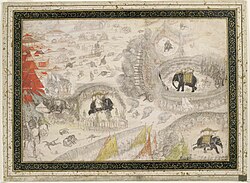Samugarh
| Battle of Samugarh | |||||||||
|---|---|---|---|---|---|---|---|---|---|
| Part of Mughal war of succession 1658–1659 | |||||||||
 Battle of Samugarh |
|||||||||
|
|||||||||
| Belligerents | |||||||||
| Mughal Empire | Mughal Empire | ||||||||
| Commanders and leaders | |||||||||
|
Aurangzeb
" Alam Hussain Lahori
|
Dara Shikoh
Ram Singh Rautela † |
||||||||
| Strength | |||||||||
|
40,000 |
60,000 80 cannons 90 swivel guns |
||||||||
| Casualties and losses | |||||||||
| 2,000 | 30,000 | ||||||||
Aurangzeb
Murad Baksh
Mir Jumla II
Kilich Khan Bahadur
" Alam Hussain Lahori
Dara Shikoh
Sulaiman Shikoh
Khalilullah Khan
Rustam Khan Deccani †
Rao Chhatrasal Hada
40,000
60 cannons
75 swivel guns
Battle of Samugarh, Jang-e-Samugarh, (May 29, 1658), was a decisive battle in the struggle for the throne during the Mughal war of succession (1658–1659) between the sons of the Mughal Emperor Shah Jahan after the emperor's serious illness in September 1657. The battle of Samugarh was fought between his sons Dara Shikoh (the eldest son and heir apparent) and his two younger brothers Aurangzeb and Murad Baksh (third and fourth sons of the Mughal Emperor Shah Jahan).
Dara Shikoh began to retreat towards Samugarh, about 10 miles (16 km) east of Agra, south of the Yamuna River, after Aurangzeb had defeated Dara Shikoh's forces during the Battle of Dharmat. Aurangzeb and his smaller but formidable army then flanked Dara’s fortified line along the Chambal River by finding a little-known and unguarded ford. The battle was fought during northern India's warmest season and Aurangzeb's men were on the march for a very long while. The army of Aurangzeb arrived with yellow banners and flags and fortified their position in front of the heir apparent. Dara Shikoh then tried to protect his rear flank by erecting massive red tents and banners.
...
Wikipedia
